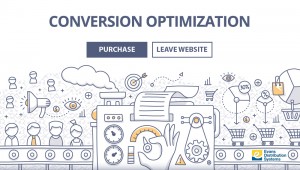10 Ways to Optimize Your E-Commerce Conversion Rate
If your conversion rate is hovering around the 5% mark, yet you’re spending a lot of money on advertising, then it is definitely time to stop and take a look at why such a large number of your visitors are turning away. With thorough analysis of the customer journey through your website, you’ll be able to better isolate the issues that are causing potential buyers to leave or even get so far as to abandon a full shopping cart. The following are ten things that every e-commerce website should have:
 Simple Navigation
Simple Navigation
Simple and intuitive navigation is essential for success, since shoppers typically won’t want to hang around for too long once they have decided to make a purchase. From the very beginning of the customer journey, it should be obvious where to go next, and your website’s interface should lead them clearly down this path with minimal distractions and a clean, clear interface devoid of unnecessary complications. Always stick to the tried-and-tested navigational methods.
Quality Images
You’ve probably come across many online stores before where the images, if there even are any, are of such a low quality that they’re largely worthless. A picture speaks a thousand words, and in some cases, an accompanying video is even more effective. People want to see what they are buying before providing you with their payment details, so take the time to publish high-resolution images with small thumbnail previews to keep page-loading times down to a minimum.
List of Product Benefits
When deciding whether or not to make a purchase, most consumers are more interested in precisely how a product or service can benefit them, rather than a more technically orientated list of specifications. While providing specifications is also important, the first thing that people should see is a list of product benefits, and these should be listed in a non-promotional and user-friendly tone. Again, accompanying images and videos can also be great for bringing these benefits to life.
Actionable Content
While you should avoid a promotional tone when listing the benefits and specifications of your product, it is important to provide some actionable content in other situations, such as email newsletters, relevant blog posts and the occasional post on social media sites relating to a particular product launch. Though the majority of your content should not be directly promotional in nature, content that has a goal to increase conversions directly should feature an actionable statement.
Offer Free Shipping
Most e-commerce stores already provide a free-shipping option for those who don’t mind waiting a few extra days for their orders to be delivered, and if you are not doing the same, you could be missing out on a whole raft of conversions. Offering free shipping is now a must, and a lack of it can lead to many people abandoning their shopping carts and looking elsewhere. Free shipping might be expensive for you, but if it means holding onto more customers, the ROI can be enormous.
Keep the Basket Visible
Many consumers like to spend quite a bit of time browsing through online shops just as they do when they go to the mall, but they usually also want to know how much they are spending. For this reason, the shopping basket should always be visible, preferably accompanied by the number of items in it as well as the total price of its content, including taxes. By having a clickable shopping basket always present, people will be able to browse through it whenever they want.
Provide Contact Information
A huge number of smaller online stores provide no contact information other than an on-site contact form. Many don’t even provide a direct email address or telephone number, let alone a physical address. As far as consumers are concerned, the lack of contact information just looks shady, and it leaves many people wondering if the company is trying to hide something. Although you’ll probably prefer people to write by email, your complete contact information should also be available.
Upsell
One of the greatest advantages of online commerce is that it provides the ability to upsell without having to risk annoying your customers. While you must avoid being intrusive (no one likes those pushy salespeople), there are many easy and even helpful ways to upsell online. You can start by providing a list of related products and services on the shopping cart page and during the checkout process. You only need to look at Amazon to see how online upselling should work.
Be Mobile-Friendly
The rise of online shopping through mobile devices such as tablets and smartphones has been unprecedented, but if your e-commerce website doesn’t provide a mobile-friendly experience, then you’re going to be missing out on a lot of potential conversions. Usually, a responsive design alone isn’t enough for an online shop, and instead you should consider providing a completely separate mobile-friendly version of the website. Larger online stores may also benefit from having a mobile app.
Have Plenty of Payment Options
Many people are understandably nervous about providing financial information online, particularly to companies that they are not familiar with. A lack of payment options is another very common reason for people to abandon a shopping cart, even if they have already spent quite some time filling it up. To help instill a sense of trust, it is also highly recommended to display payment validation certificates, such as “Verified by Visa” and “MasterCard SecureCode” alongside your payment options.
Conclusion
Of course, this list is not complete, but the above tips are among the most important for optimizing your customer journey and minimizing the risk of shopping-cart abandonment. On a final note, be sure to track and test the customer journey at every step of the way so that you can quickly uncover any holes that may be costing you conversions and valuable revenue.
